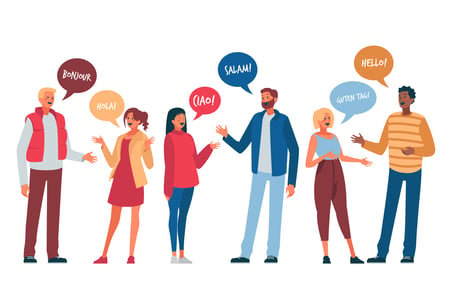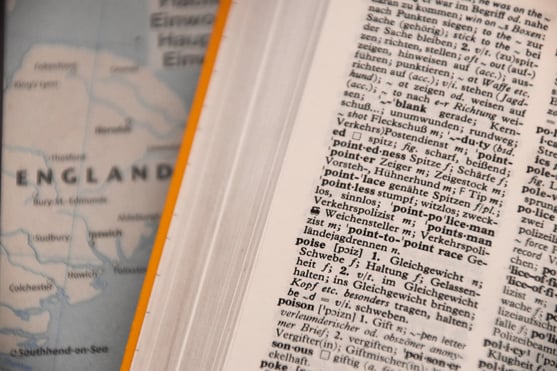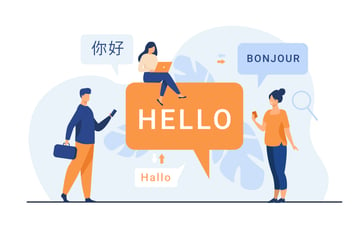What is Language Access?
Why is Language Access Important?
How would you navigate a visit to the hospital if no one else spoke English?
How would you file your taxes on a form that wasn't written in English?
This lack of understanding exists for individuals who can't speak or understand English. So how should they obtain the services that you and I receive daily?
English is not accessible.
The biggest obstacle facing language access is the lack of understanding. Is this page the first time you've really thought about the topic?
Who is affected?
Language access is important for groups that use languages other than English to interact and communicate with the world around them. This includes groups of people who don't understand the language, such as limited-English proficient (LEP) individuals, and people who cannot hear the language effectively, such as deaf or hard-of-hearing individuals.
Deaf
Over 430 people worldwide have disabling hearing loss, over 5% of the world's population.
When hearing loss is so profound that someone has no functional hearing, they are considered deaf. People who are deaf in the US often learn American Sign Language (ASL). This will help them to communicate with other members of their Deaf communities, but there will be a language barrier between ASL and English.
A couple of myths have popped up about communicating with deaf individuals, but at the end of the day, if they communicate using ASL, you need to understand or interpret communication with them.
- Myth 1. Deaf people can read lips.
30% of a message can be perceived in the lips. The rest of the message is formed through inflections, nonverbals, and more.
- Myth2. Deaf people can provide pen and paper for communication.
Not every hearing person can effectively read and write in English, so ho can we expect every Deaf person to?
Communication with Deaf and hard-of-hearing individuals is guaranteed under the Americans with Disabilities Act.
Limited-English Proficiency (LEP)
Not everyone in the US has learned English, 8.2% of people rate their English speaking skills as "less than very well." This means that 8.2% of Americans will struggle to navigate vital resources that communicate using English.
Like the Deaf community, language access has been attempted in ineffective ways. 90% of immigrant youth will broker language for their parents. They will be required to break down complex topics such as healthcare, taxes, and government services without the required knowledge or experience.
Effective language access would instead put trained interpreters and translators between these communities and the services they need.
Title VI of the Civil Rights Act of 1964 covers the right of non-English speakers to access information from covered entities.

What are the tools for language access?
There are a plethora of providers and tools that help overcome communication barriers. All of them aim to provide access to services for Deaf, hard-of-hearing, and LEP communities that are equal to the hearing and English-proficient population. But this can be boiled down to two main areas:
- Oral interpreting services
- Vital document translation
Oral Interpreters
For services provided in real-time, an interpreter is necessary to convert language and culture between the interacting parties. Services exist for situations that occur in person or virtually.
- Onsite interpreting - Where all parties, and the interpreter, are in the same room.
- Video remote interpreting (VRI) - Parties use a virtual tool to connect with an interpreter over video. This can facilitate communication between spoken and sign language.
- Over-the-phone interpreting (OPI) - Parties use a virtual tool to connect with an interpreter over audio. It can only be used for spoken languages.
Interpreters are beneficial in that they can specialize in certain areas such as healthcare, law, business, and more. This further ensures that the message is maintained between parties in a way that using family members can't necessarily do.

Document Translation
Document translation becomes quicker and cheaper daily, but not everyone thinks to use it. Documents like brochures, flyers, and forms can all be provided in the native language of the recipient, which would allow it to be understood more widely and effectively.
Common examples include:
- Translating a driver's license or immigration form
- Translating an Individualized Education Plan for Students
- Translation of information about government services
Translations are in an interesting place right now, with the rise of AI and the continued growth of Google Translate, but often these tools aren't enough. One constant issue with these tools is a lack of ability to translate culture, a vital message component. If your message is long or complex, introducing a certified translator ensures effective communication across languages and cultures.
How can you help provide language access?
Having read this article, your interest in language access helps elevate the conversation and advocate for communities in need. Learning more and sharing resources can help language access for free.
Or, if you are part of a business that serves (or could serve) communities that struggle to overcome language barriers, consider creating a plan to use the abovementioned tools. Many companies provide certified interpreting services and certified translation.
Global Interpreting Services provides solutions for businesses to obtain interpreting and translation tools. If you're ready to discuss how to provide better language access, fill out our form to start the conversation.

What's next for language access?
Language access is a topic with growing popularity. In Michigan, many bills that would greatly benefit communities that don't speak or understand English are being considered. It is crucial that we highlight these attempts to make language more accessible for individuals who are Deaf, hard-of-hearing, or LEP.
